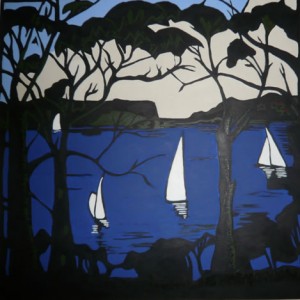Sydney Heads, 1925, woodcut, printed in black ink on paper, from one block, hand-coloured, 186mm x 252mm, by Margaret Preston (1875-1963), copy by Derek Kosbab
Margaret Preston’s original of this artwork was just 186mm x 252mm was a woodcut, printed in black ink on paper, from one block and hand-coloured. My copy is square and more than three times larger.
When she died in Sydney in 1963, Hal Missingham wrote: ” . . . if Margaret Preston had been a man I feel sure she would have enjoyed a public reputation equally as great as Dobell, Drysdale or Nolan in our time. But she was belligerently and seductively a woman, proud of it, and imperious in her demand that she be accepted as an artist.”
These sentiments by the then director of the Art Gallery NSW now read curiously, and not just because we have become used to valedictory accounts of Australian women artists who developed modernist practices between the wars (Grace Crowley, Grace Cossington Smith, Dorit Black, Stella Bowen and Anne Dangar working in Europe, Thea Proctor, Gladys Reynell, off the top of my head).
Rather, they seem at odds with the life and artistic success celebrated in the excellent catalogue to this travelling exhibition from the Art Gallery of NSW (all 300 pages of it and, given the paucity of wall texts, you should peruse it before you see the show).
Did Missingham unconsciously conflate still lifes, usually with flowers, with being a woman? If you substitute the words “portrait or landscape painter” for the word “man” above, and “flower painter” for “woman”, you arrive at something much closer to Preston’s own account of her career.
And whether her gender was a matter for belligerence is something to which her former Adelaide students and, at different times, also long-term companions Bessie Davidson (a student from 1899; travelling companion in Europe from 1904 to the end of 1906) and Reynell (a student from 1907; travelling companion in Europe from 1912 to 1919) could have attested. To me, she seems to have enjoyed, if not demanded and understood, the best of differently gendered worlds: so much so that when she decided to marry, at the age of 44, she took her husband’s name and eight years off her age.
With a devoted and comfortably-off spouse (they employed a maid – see the portrait painting Flapper, 1928) and a supportive friend and publisher in Sydney, Ure Smith, Preston, in the latter half of her life, indulged her love of travel, becoming a travel writer and an advocate for an Australian art based on indigenous precedents.
$1,500.00 via PayPal
Acrylic on canvas: 760mm x 760 mm
